Yi Mei
DyRo-MCTS: A Robust Monte Carlo Tree Search Approach to Dynamic Job Shop Scheduling
Sep 26, 2025Abstract:Dynamic job shop scheduling, a fundamental combinatorial optimisation problem in various industrial sectors, poses substantial challenges for effective scheduling due to frequent disruptions caused by the arrival of new jobs. State-of-the-art methods employ machine learning to learn scheduling policies offline, enabling rapid responses to dynamic events. However, these offline policies are often imperfect, necessitating the use of planning techniques such as Monte Carlo Tree Search (MCTS) to improve performance at online decision time. The unpredictability of new job arrivals complicates online planning, as decisions based on incomplete problem information are vulnerable to disturbances. To address this issue, we propose the Dynamic Robust MCTS (DyRo-MCTS) approach, which integrates action robustness estimation into MCTS. DyRo-MCTS guides the production environment toward states that not only yield good scheduling outcomes but are also easily adaptable to future job arrivals. Extensive experiments show that DyRo-MCTS significantly improves the performance of offline-learned policies with negligible additional online planning time. Moreover, DyRo-MCTS consistently outperforms vanilla MCTS across various scheduling scenarios. Further analysis reveals that its ability to make robust scheduling decisions leads to long-term, sustainable performance gains under disturbances.
Bridging Fitness With Search Spaces By Fitness Supremums: A Theoretical Study on LGP
May 28, 2025Abstract:Genetic programming has undergone rapid development in recent years. However, theoretical studies of genetic programming are far behind. One of the major obstacles to theoretical studies is the challenge of developing a model to describe the relationship between fitness values and program genotypes. In this paper, we take linear genetic programming (LGP) as an example to study the fitness-to-genotype relationship. We find that the fitness expectation increases with fitness supremum over instruction editing distance, considering 1) the fitness supremum linearly increases with the instruction editing distance in LGP, 2) the fitness infimum is fixed, and 3) the fitness probabilities over different instruction editing distances are similar. We then extend these findings to explain the bloat effect and the minimum hitting time of LGP based on instruction editing distance. The bloat effect happens because it is more likely to produce better offspring by adding instructions than by removing them, given an instruction editing distance from the optimal program. The analysis of the minimum hitting time suggests that for a basic LGP genetic operator (i.e., freemut), maintaining a necessarily small program size and mutating multiple instructions each time can improve LGP performance. The reported empirical results verify our hypothesis.
LiBOG: Lifelong Learning for Black-Box Optimizer Generation
May 19, 2025Abstract:Meta-Black-Box Optimization (MetaBBO) garners attention due to its success in automating the configuration and generation of black-box optimizers, significantly reducing the human effort required for optimizer design and discovering optimizers with higher performance than classic human-designed optimizers. However, existing MetaBBO methods conduct one-off training under the assumption that a stationary problem distribution with extensive and representative training problem samples is pre-available. This assumption is often impractical in real-world scenarios, where diverse problems following shifting distribution continually arise. Consequently, there is a pressing need for methods that can continuously learn from new problems encountered on-the-fly and progressively enhance their capabilities. In this work, we explore a novel paradigm of lifelong learning in MetaBBO and introduce LiBOG, a novel approach designed to learn from sequentially encountered problems and generate high-performance optimizers for Black-Box Optimization (BBO). LiBOG consolidates knowledge both across tasks and within tasks to mitigate catastrophic forgetting. Extensive experiments demonstrate LiBOG's effectiveness in learning to generate high-performance optimizers in a lifelong learning manner, addressing catastrophic forgetting while maintaining plasticity to learn new tasks.
One Trigger Token Is Enough: A Defense Strategy for Balancing Safety and Usability in Large Language Models
May 12, 2025Abstract:Large Language Models (LLMs) have been extensively used across diverse domains, including virtual assistants, automated code generation, and scientific research. However, they remain vulnerable to jailbreak attacks, which manipulate the models into generating harmful responses despite safety alignment. Recent studies have shown that current safety-aligned LLMs often undergo the shallow safety alignment, where the first few tokens largely determine whether the response will be harmful. Through comprehensive observations, we find that safety-aligned LLMs and various defense strategies generate highly similar initial tokens in their refusal responses, which we define as safety trigger tokens. Building on this insight, we propose \texttt{D-STT}, a simple yet effective defense algorithm that identifies and explicitly decodes safety trigger tokens of the given safety-aligned LLM to trigger the model's learned safety patterns. In this process, the safety trigger is constrained to a single token, which effectively preserves model usability by introducing minimum intervention in the decoding process. Extensive experiments across diverse jailbreak attacks and benign prompts demonstrate that \ours significantly reduces output harmfulness while preserving model usability and incurring negligible response time overhead, outperforming ten baseline methods.
ParetoHqD: Fast Offline Multiobjective Alignment of Large Language Models using Pareto High-quality Data
Apr 23, 2025Abstract:Aligning large language models with multiple human expectations and values is crucial for ensuring that they adequately serve a variety of user needs. To this end, offline multiobjective alignment algorithms such as the Rewards-in-Context algorithm have shown strong performance and efficiency. However, inappropriate preference representations and training with imbalanced reward scores limit the performance of such algorithms. In this work, we introduce ParetoHqD that addresses the above issues by representing human preferences as preference directions in the objective space and regarding data near the Pareto front as ''high-quality'' data. For each preference, ParetoHqD follows a two-stage supervised fine-tuning process, where each stage uses an individual Pareto high-quality training set that best matches its preference direction. The experimental results have demonstrated the superiority of ParetoHqD over five baselines on two multiobjective alignment tasks.
Generalized Phase Pressure Control Enhanced Reinforcement Learning for Traffic Signal Control
Mar 26, 2025Abstract:Appropriate traffic state representation is crucial for learning traffic signal control policies. However, most of the current traffic state representations are heuristically designed, with insufficient theoretical support. In this paper, we (1) develop a flexible, efficient, and theoretically grounded method, namely generalized phase pressure (G2P) control, which takes only simple lane features into consideration to decide which phase to be actuated; 2) extend the pressure control theory to a general form for multi-homogeneous-lane road networks based on queueing theory; (3) design a new traffic state representation based on the generalized phase state features from G2P control; and 4) develop a reinforcement learning (RL)-based algorithm template named G2P-XLight, and two RL algorithms, G2P-MPLight and G2P-CoLight, by combining the generalized phase state representation with MPLight and CoLight, two well-performed RL methods for learning traffic signal control policies. Extensive experiments conducted on multiple real-world datasets demonstrate that G2P control outperforms the state-of-the-art (SOTA) heuristic method in the transportation field and other recent human-designed heuristic methods; and that the newly proposed G2P-XLight significantly outperforms SOTA learning-based approaches. Our code is available online.
Emergent Crowd Grouping via Heuristic Self-Organization
Jun 30, 2024Abstract:Modeling crowds has many important applications in games and computer animation. Inspired by the emergent following effect in real-life crowd scenarios, in this work, we develop a method for implicitly grouping moving agents. We achieve this by analyzing local information around each agent and rotating its preferred velocity accordingly. Each agent could automatically form an implicit group with its neighboring agents that have similar directions. In contrast to an explicit group, there are no strict boundaries for an implicit group. If an agent's direction deviates from its group as a result of positional changes, it will autonomously exit the group or join another implicitly formed neighboring group. This implicit grouping is autonomously emergent among agents rather than deliberately controlled by the algorithm. The proposed method is compared with many crowd simulation models, and the experimental results indicate that our approach achieves the lowest congestion levels in some classic scenarios. In addition, we demonstrate that adjusting the preferred velocity of agents can actually reduce the dissimilarity between their actual velocity and the original preferred velocity. Our work is available online.
Multi-Representation Genetic Programming: A Case Study on Tree-based and Linear Representations
May 23, 2024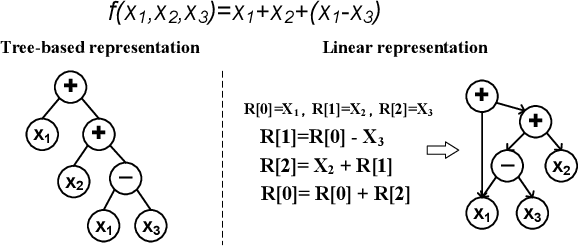
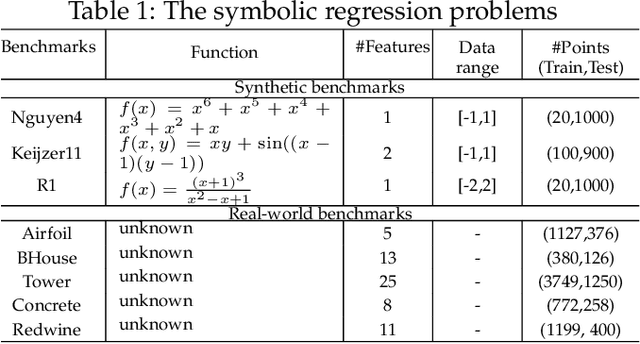
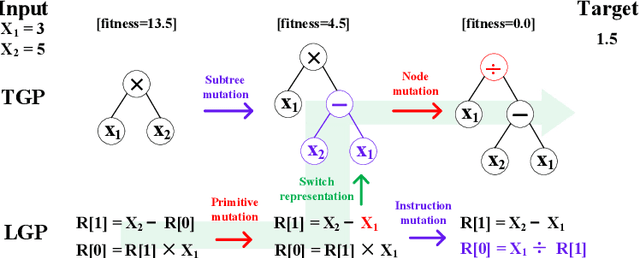
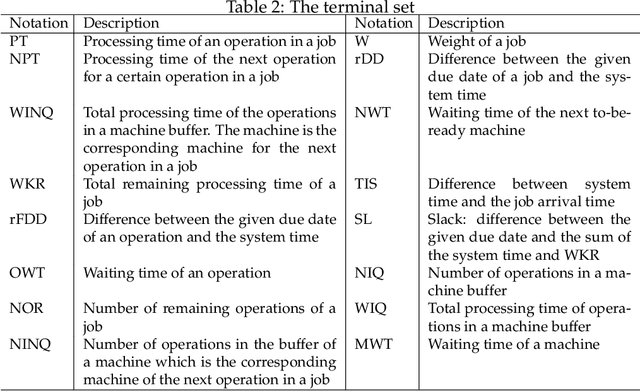
Abstract:Existing genetic programming (GP) methods are typically designed based on a certain representation, such as tree-based or linear representations. These representations show various pros and cons in different domains. However, due to the complicated relationships among representation and fitness landscapes of GP, it is hard to intuitively determine which GP representation is the most suitable for solving a certain problem. Evolving programs (or models) with multiple representations simultaneously can alternatively search on different fitness landscapes since representations are highly related to the search space that essentially defines the fitness landscape. Fully using the latent synergies among different GP individual representations might be helpful for GP to search for better solutions. However, existing GP literature rarely investigates the simultaneous effective use of evolving multiple representations. To fill this gap, this paper proposes a multi-representation GP algorithm based on tree-based and linear representations, which are two commonly used GP representations. In addition, we develop a new cross-representation crossover operator to harness the interplay between tree-based and linear representations. Empirical results show that navigating the learned knowledge between basic tree-based and linear representations successfully improves the effectiveness of GP with solely tree-based or linear representation in solving symbolic regression and dynamic job shop scheduling problems.
Learning from Offline and Online Experiences: A Hybrid Adaptive Operator Selection Framework
Apr 16, 2024Abstract:In many practical applications, usually, similar optimisation problems or scenarios repeatedly appear. Learning from previous problem-solving experiences can help adjust algorithm components of meta-heuristics, e.g., adaptively selecting promising search operators, to achieve better optimisation performance. However, those experiences obtained from previously solved problems, namely offline experiences, may sometimes provide misleading perceptions when solving a new problem, if the characteristics of previous problems and the new one are relatively different. Learning from online experiences obtained during the ongoing problem-solving process is more instructive but highly restricted by limited computational resources. This paper focuses on the effective combination of offline and online experiences. A novel hybrid framework that learns to dynamically and adaptively select promising search operators is proposed. Two adaptive operator selection modules with complementary paradigms cooperate in the framework to learn from offline and online experiences and make decisions. An adaptive decision policy is maintained to balance the use of those two modules in an online manner. Extensive experiments on 170 widely studied real-value benchmark optimisation problems and a benchmark set with 34 instances for combinatorial optimisation show that the proposed hybrid framework outperforms the state-of-the-art methods. Ablation study verifies the effectiveness of each component of the framework.
Learning Traffic Signal Control via Genetic Programming
Mar 26, 2024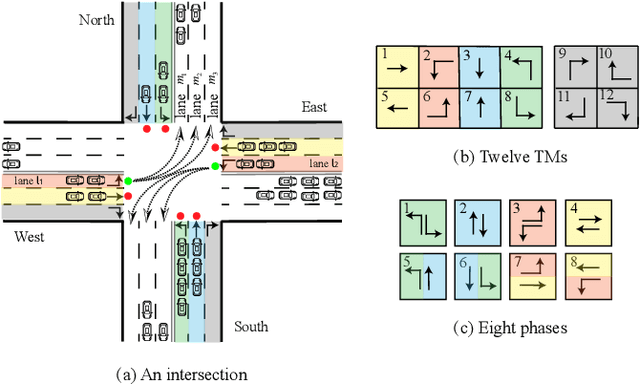
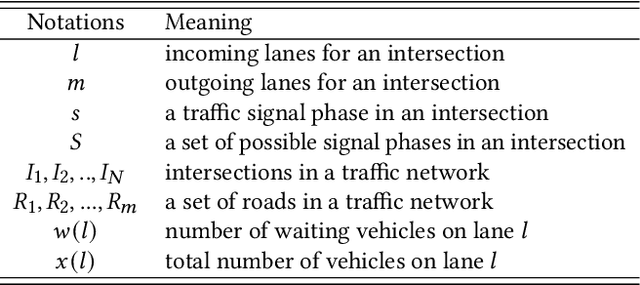
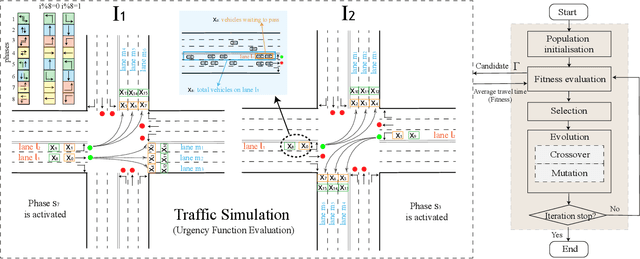
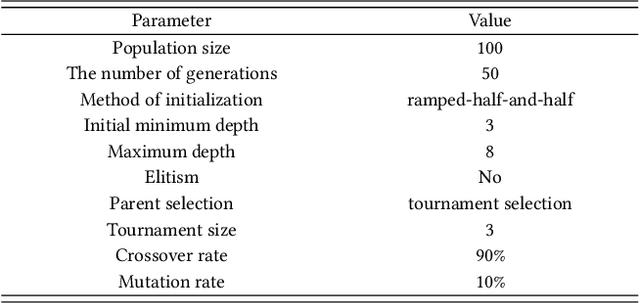
Abstract:The control of traffic signals is crucial for improving transportation efficiency. Recently, learning-based methods, especially Deep Reinforcement Learning (DRL), garnered substantial success in the quest for more efficient traffic signal control strategies. However, the design of rewards in DRL highly demands domain knowledge to converge to an effective policy, and the final policy also presents difficulties in terms of explainability. In this work, a new learning-based method for signal control in complex intersections is proposed. In our approach, we design a concept of phase urgency for each signal phase. During signal transitions, the traffic light control strategy selects the next phase to be activated based on the phase urgency. We then proposed to represent the urgency function as an explainable tree structure. The urgency function can calculate the phase urgency for a specific phase based on the current road conditions. Genetic programming is adopted to perform gradient-free optimization of the urgency function. We test our algorithm on multiple public traffic signal control datasets. The experimental results indicate that the tree-shaped urgency function evolved by genetic programming outperforms the baselines, including a state-of-the-art method in the transportation field and a well-known DRL-based method.
 Add to Chrome
Add to Chrome Add to Firefox
Add to Firefox Add to Edge
Add to Edge